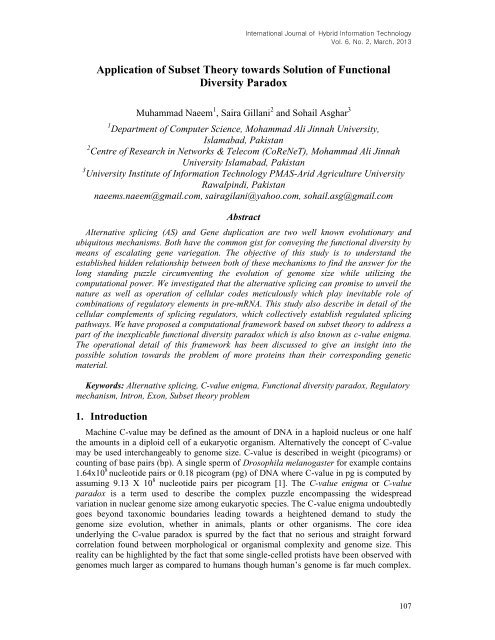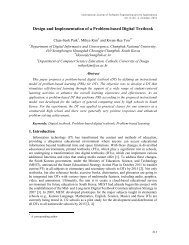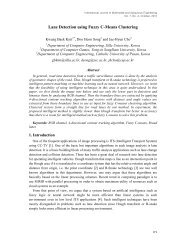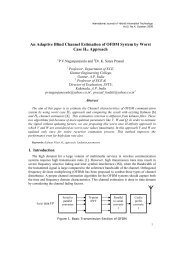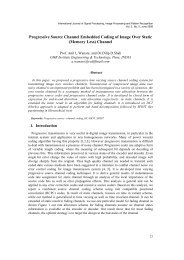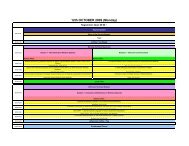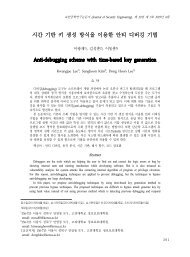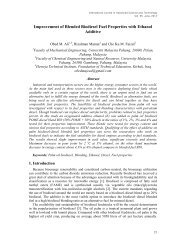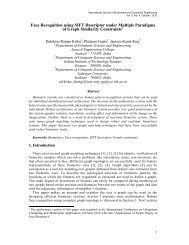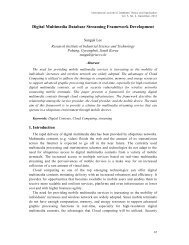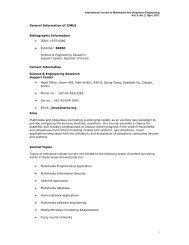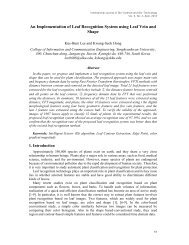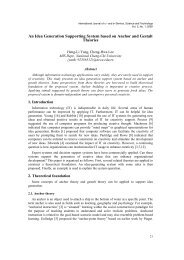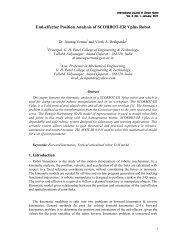Create successful ePaper yourself
Turn your PDF publications into a flip-book with our unique Google optimized e-Paper software.
International <strong>Journal</strong> of Hybrid Information Technology<br />
Vol. 6, No. 2, March, 2013<br />
Application of Subset Theory towards Solution of Functional<br />
Diversity Paradox<br />
Muhammad Naeem 1 , Saira Gillani 2 and Sohail Asghar 3<br />
1 Department of Computer Science, Mohammad Ali Jinnah University,<br />
Islamabad, Pakistan<br />
2 Centre of Research in Networks & Telecom (CoReNeT), Mohammad Ali Jinnah<br />
University Islamabad, Pakistan<br />
3 University Institute of Information Technology PMAS-Arid Agriculture University<br />
Rawalpindi, Pakistan<br />
naeems.naeem@gmail.com, sairagilani@yahoo.com, sohail.asg@gmail.com<br />
Abstract<br />
Alternative splicing (AS) and Gene duplication are two well known evolutionary and<br />
ubiquitous mechanisms. Both have the common gist for conveying the functional diversity by<br />
means of escalating gene variegation. The objective of this study is to understand the<br />
established hidden relationship between both of these mechanisms to find the answer for the<br />
long standing puzzle circumventing the evolution of genome size while utilizing the<br />
computational power. We investigated that the alternative splicing can promise to unveil the<br />
nature as well as operation of cellular codes meticulously which play inevitable role of<br />
combinations of regulatory elements in pre-mRNA. This study also describe in detail of the<br />
cellular complements of splicing regulators, which collectively establish regulated splicing<br />
pathways. We have proposed a computational framework based on subset theory to address a<br />
part of the inexplicable functional diversity paradox which is also known as c-value enigma.<br />
The operational detail of this framework has been discussed to give an insight into the<br />
possible solution towards the problem of more proteins than their corresponding genetic<br />
material.<br />
Keywords: Alternative splicing, C-value enigma, Functional diversity paradox, Regulatory<br />
mechanism, Intron, Exon, Subset theory problem<br />
1. Introduction<br />
Machine C-value may be defined as the amount of DNA in a haploid nucleus or one half<br />
the amounts in a diploid cell of a eukaryotic organism. Alternatively the concept of C-value<br />
may be used interchangeably to genome size. C-value is described in weight (picograms) or<br />
counting of base pairs (bp). A single sperm of Drosophila melanogaster for example contains<br />
1.64x10 8 nucleotide pairs or 0.18 picogram (pg) of DNA where C-value in pg is computed by<br />
assuming 9.13 X 10 8 nucleotide pairs per picogram [1]. The C-value enigma or C-value<br />
paradox is a term used to describe the complex puzzle encompassing the widespread<br />
variation in nuclear genome size among eukaryotic species. The C-value enigma undoubtedly<br />
goes beyond taxonomic boundaries leading towards a heightened demand to study the<br />
genome size evolution, whether in animals, plants or other organisms. The core idea<br />
underlying the C-value paradox is spurred by the fact that no serious and straight forward<br />
correlation found between morphological or organismal complexity and genome size. This<br />
reality can be highlighted by the fact that some single-celled protists have been observed with<br />
genomes much larger as compared to humans though human’s genome is far much complex.<br />
107
International <strong>Journal</strong> of Hybrid Information Technology<br />
Vol. 6, No. 2, March, 2013<br />
Such observation may negate the popular evolutionary theory. Briefly but important and<br />
independent component question of the C-value enigma can be summarized as:<br />
What types of non-coding DNA are found in different eukaryotic genomes, and in what<br />
proportions?<br />
Gregory [2] illustrated some interesting statistical values related to C-value enigma for<br />
haploid nuclear DNA over the data summarized. The graph is plotted between C-value in<br />
picogram versus various species. Vertical line in each bar is portraying the average of C-value.<br />
The graph is depicting that most C-value in animals as well as in plants are small with a few<br />
exceptions of some groups. Gregory [2] showed in this graph that there is no correlation or<br />
connection ever observed so far between the complexity of different species and their related<br />
genome size. Gregory in quest of investigation for C-value paradox reported that variation in<br />
genome size is principally due to direct selection on the amount of bulk DNA through its<br />
underlying effects on cell volume and organismal cellular characteristics [2, 3, 4].<br />
Second part of this puzzle narrates that “From where does this non-coding DNA come, and<br />
how is it spread and/or lost from genomes over time?”<br />
C-value puzzle has been a renowned problem in the field of molecular biology. It can be<br />
concluded that species related specific characteristics emerged as a surprise to the early<br />
researchers where several orders of magnitude of genome materials was revealed among<br />
various eukaryotes. It was stated that “the lowly liverwort has 18 times as much DNA as we,<br />
and the slimy, dull salamander known as Amphiuma has 26 times our complement of DNA”<br />
[5].<br />
Third part of the puzzle describes: “What effects, or perhaps even functions, does this noncoding<br />
DNA have for chromosomes, nuclei, cells, and organisms?”<br />
A possible answer to solve this puzzle leads to develop two broad kinds of theories. These<br />
include mutation pressure and optimal DNA theory. In mutation pressure theory, major<br />
portion of non-coding DNA in eukaryotic genomes is considered as junk or selfish DNA. The<br />
role of non coding DNA is limited to only evolution of secondary DNA through<br />
transcriptional and translational regulation of protein-coding sequences. On the other hand<br />
optimal DNA theory is focused on highlighting the strong connection between DNA content,<br />
cell and nuclear volumes. Most of the available evidences go in favor of later theory. Gregory<br />
(2001) developed a model of nucleotypic influence which falls under the category of optimal<br />
DNA theory. They by means of the result obtained from this model, concluded that large<br />
amounts of DNA exhibit large and slowly dividing cells.<br />
Fourth part of the C-value enigma argues: “Why do some species exhibit remarkably<br />
streamlined chromosomes, while others possess massive amounts of non-coding DNA?”<br />
Analysis of genome size is directly related to the understanding of the functions of genetic<br />
material. Such analysis leads to the scrutinization of mRNA diversity which acts as a<br />
signature of genome functionality. The foundation of novel genes and its associated new<br />
functionalities is an important step towards evolution of organisms [6]. It was reported that<br />
more than seventy percent of whole human genetic material can generate multiple transcripts<br />
via alternative splicing [7, 8]. Exon shuffling, gene duplication, lateral gene transfer, retro<br />
position, de novo origination and gene fission/fusion are considered essential means in novel<br />
genes generation [8, 9, 10]. Alternative splicing can be considered as an essential step<br />
towards proteome diversity and transcriptome. This makes alternative splicing an exciting and<br />
appealing area of interest during the evolutionary course. Although new genes typically<br />
108
International <strong>Journal</strong> of Hybrid Information Technology<br />
Vol. 6, No. 2, March, 2013<br />
evolve swiftly in structure, sequences and expression, the evolutionary pattern of alternative<br />
splicing in new genes and the molecular mechanisms involved in this alternation still needs to<br />
be investigated in depth [6].<br />
In the domain of molecular biology, splicing can be described as a posttranscriptional<br />
alteration of RNA. The discovery of RNA splicing was made during 1970s, an era considered<br />
as overturning years in the domain of gene expression. In the same period it was also<br />
discovered that some of the RNA molecules have the ability to splice themselves; this<br />
discovery of self-splicing ability in the protozoan Tetrahymena thermophila was awarded<br />
with the Nobel Prize in 1989. Splicing is characterized by the removal of intron followed by<br />
fusion of remaining exons. Splicing is a mandatory requirement for the classic eukaryotic<br />
mRNA prior to its translation into proteins. Splicing in majority of eukaryotic introns is<br />
performed in a chain of reactions. This chain of reactions includes catalyzation by the<br />
spliceosome, a complex of small nuclear ribonucleoproteins, and self-splicing introns. The<br />
exon composition of the same mRNA can be rearranged in diversified patterns yielding a<br />
variety of unique proteins. In molecular biology, such phenomenon can be described as<br />
alternative splicing. Alternative splicing can take place in variety of ways including extending<br />
exons, skipping exons or even retaining one or more introns.<br />
The last but not least part of the quiz give forth the question: “Why does the number of<br />
proteins exceed the number of protein coding genes?”<br />
In this paper, the study investigated is explicitly not an examination of all of the questions<br />
formulated in notable C-value enigma, rather we have targeted towards the last question of<br />
this paradox. We have proposed a computational approach towards the solution of the C-<br />
value enigma. Our study pointed out that a part of this problem can be resolved by means of<br />
mathematical set theory problem. Our approach is focused on converting a big set into<br />
smaller sub set. The cross intersection of these entire sub-sets may give rise to all of the<br />
possible candidate protein out of DNA/mRNA genetic material.<br />
Wakamatsu, et al., [11] examined the mRNA diversity of genes after inducing neuronal<br />
differentiation in human NT2 teratocarcinoma cells using all-transcriptional retinoic acid<br />
(RA). Their examination brought the results that 274 genes generated multiple protein-coding<br />
transcripts by means of alternative splicing. They also identified that gene exhibiting different<br />
RNA-induced alters in the expression of their protein-coding transcripts. Zhan, et al., [6]<br />
identified new genes in the Drosophila melanogaster lineage while investigating alternative<br />
splicing and possible functional consequences of these genes. They also argued that new<br />
genes tend towards exhibiting low degree of alternative splicing. They highlighted that loss of<br />
introns in retroposed new genes is responsible for one third of the low-level alternative<br />
splicing, whereas partial gene duplication without alternative splicing exons and mutations in<br />
the duplicated alternative splicing exons/introns collectively have resulted in two-third<br />
alternative splicing losses in new genes. They concluded that reducing the degree of<br />
alternative splicing is a broader inclination towards all categories of new genes. They<br />
described that alternative splicing with tissue expression pattern of new genes had somewhat<br />
less expression level. Zhan, et al., [6] concluded that these new genes are likely to have<br />
gained diverged structures and expression patterns from their parental genes after alternative<br />
splicing. Matuda, et al., [12] investigated alternative splicing for dihydrolipoamide<br />
succinyltransferase (DLST) gene which is a mitochondrial protein. They identified an<br />
uncharacterized protein found reacting with an anti-DLST antibody in the I bands of<br />
myofibrils in rat skeletal muscle. Their results implied that a pyrophosphate concentration<br />
N10 mM was mandatory to elicit the protein from myofibrils in the presence of salt with a<br />
higher concentration than 0.6 M, at an alkaline pH of 7.5–8.0.<br />
109
International <strong>Journal</strong> of Hybrid Information Technology<br />
Vol. 6, No. 2, March, 2013<br />
Jin, et al., [13] described that gene duplication and alternative splicing are two main<br />
evolutionary mechanisms responsible for the functional variation by means of enhancing gene<br />
diversification. They implied that the proportion of alternative splicing loci and the average<br />
number of alternative splicing isoforms per locus are observed larger in duplicated genes in<br />
comparison to those in singleton genes while establishing the evolutionary relationship<br />
between gene duplication and alternative splicing. They also showed that small gene families<br />
have larger proportion of alternative splicing while larger average number of alternative<br />
isoforms per locus than large gene families.<br />
Lareau, et al., [14] argued that human genome has far fewer genes than expected. They<br />
described that alternative splicing may give rise to proteome expansion while bridging a<br />
perceived complexity gap. They also argued that alternative splicing may be commonly<br />
believed to affect more than half of human genes. It was concluded that alternative splicing<br />
may lead to multiple alternatively spliced mRNA isoforms, resulting generation of mature<br />
mRNAs and ultimately polypeptides which can be remarkably related or highly different<br />
while originating from the same locus [15, 16]. Black (2003) implied that alternative splicing<br />
is a core model in genetic regulation. They described that diversity in splicing patterns is a<br />
crucial source of protein diversity from the genome. They discussed about the combination of<br />
tissue specific splicing complex system using the Drosophila sex determination pathways.<br />
It was reported this fact that there exist a violation of the concept stating ‘one gene, one<br />
polypeptide’ axiom [16]. They argued that alternative splicing permits individual genes to<br />
express multiple protein isoforms. Such role of alternative splicing eventually results in<br />
generating complex proteomes. It was also described that in the area of quantitative gene<br />
control, alternative splicing may exhibit many concealed functionalities. Exhibitions of these<br />
hidden functionalities can be achieved by targeting RNAs for nonsense-mediated decay. They<br />
described that conventional gene-by-gene examination of alternative splicing mechanisms can<br />
be accomplished by global approaches.<br />
Marcus [17] proposed a partial solution to the C-value enigma. They described that during<br />
half century, no explicit statistical comparisons between C-value size to its corresponding<br />
organism complication have been presented. However, performing their experimentation of<br />
sequenced genomes on 139 prokaryotic and eukaryotic organisms they highlighted that there<br />
are noteworthy positive correlations may likely exist between measures of genome size to its<br />
complexity in comparison to measures of non-hierarchical morphological complexity. They<br />
observed that these correlations are non-trivial to correction for phylogenetic history by<br />
means of independent contrasts. They reported that the C-value enigma is likely to be more<br />
apparent in smaller genomes organisms. They also reasoned out that morphological<br />
complexity and genome complexity correlate positively with one another considerably in fact.<br />
Koren, et al., [18] described that Alternative 3′ and 5′ splice site events comprise a non<br />
trivial role among all of the alternative splicing events. They showed the correlation of these<br />
events to various splicing diseases. They also described that a limited distinguishing features<br />
have been identified so far which are related to alternative cassette exons. They identified<br />
important features of constitutive exons, alternative cassette exons, alternative 3′ss and 5′ss<br />
exons. Their results discovered that alternative 3′ss and 5′ss exons are observed in between<br />
constitutive and alternative cassette exons, while the constitutive side and alternative side<br />
look a lot like constitutive exons, and alternative cassette exons respectively. The other<br />
interesting discovery was related to symmertry level feature of both altervative 3′ss and 5′ss<br />
exons showing low frame-preservation effect while the sequence between both of them<br />
exhibit high symmetry levels.<br />
110
International <strong>Journal</strong> of Hybrid Information Technology<br />
Vol. 6, No. 2, March, 2013<br />
2. Methodology<br />
Based on the literature review investigated, we concluded that though a partial answer to<br />
C-value enigma appeared when non-coding DNA was explored. However, C-value enigma<br />
related to one protein per polypeptide hypothesis still not clearly enlightened. We introduced<br />
a computational heuristic to solve the issue of inconsistency between the numbers of proteins<br />
to their relevant protein coding genes issue. The input of the proposed technique in this<br />
methodology will be DNA material in fasta format. The final outcome of the technique will<br />
be a complete list of all proteins which can be expressed out of any given nucleotide sequence<br />
of DNA or RNA .<br />
2.1 Statement of Alternating Splicing Problem<br />
Alternative splicing problem is to identify the genomic sequence. A gene is a set of exons,<br />
intron and poly-A tails. Each of them is a substring of genomic sequence G such that<br />
G i<br />
Exon | Intron | Poly A where Г { g1,<br />
g2,.....<br />
gn}<br />
is of substring with g 1<br />
gn<br />
.<br />
Algorithm 1 describes the possible implementation of alternative splicing technique. It<br />
starts by selecting the genes nucleotide sequences. The next step is to initialize these<br />
sequences. The algorithm selects each of the genomic sequence comprising of a series of<br />
nucleotide sequence. Each genomic sequence is subjected to all of the steps as described in<br />
the Figure 2 of proposed.<br />
G { g , g , g .... g }<br />
1<br />
GeneSet G { g , g , g ... g }<br />
g<br />
G<br />
2<br />
if ValidateNu cleotideBa se(<br />
g)<br />
false<br />
G G g<br />
if startSignal(<br />
g)<br />
false<br />
G G g<br />
if stopSignal(<br />
g)<br />
false<br />
G G g<br />
3<br />
1<br />
n<br />
2<br />
if countBaseNucleotide ( g)<br />
threshold<br />
3<br />
n<br />
G G g<br />
g B ( Adenine Uracine<br />
Cytocine Guanine)}<br />
b i B<br />
b,<br />
b g<br />
if ( b Mar ker[ i])<br />
B B b<br />
sp Identifica tion(<br />
g,<br />
Codon,<br />
B)<br />
Splicesite Splicesite sp<br />
in Identifica tion(<br />
g,<br />
B)<br />
Intron Intron in<br />
en Identifica tion(<br />
g,<br />
B)<br />
Exon Exon en<br />
111
International <strong>Journal</strong> of Hybrid Information Technology<br />
Vol. 6, No. 2, March, 2013<br />
if g {<br />
SingleExon , SingleIntron<br />
, SinglePoly A,<br />
SingleUTR}<br />
Stop<br />
in<br />
int<br />
ron en<br />
exon<br />
pl<br />
PolyA<br />
possible _ proteinSet Combine(<br />
in,<br />
ex,<br />
pl)<br />
pt<br />
possible _ proteinSet<br />
proteinSet UniprotAPI<br />
( pt)<br />
Figure 1. Algorithm for Computational Solution<br />
Figure 2. Proposed Methodology for Computational Solution of c-Value Enigma<br />
In the Figure 2, we have shown our proposed methodology. This methodology consists of<br />
following steps.<br />
Step-I. DNA Genes Acquisition: This step deals with the preprocessing of the raw data<br />
obtained from various biological data source web sites. An important feature of all of these<br />
steps is that from step one to last step, all data is also being stored in a database so that an<br />
archive can be generated. Such archival repository may be helpful for in depth analysis or<br />
data mining of genes, proteins and RNA data.<br />
Step-II. Validation of DNA Genes: Validity of the DNA genes is an important step in any<br />
methodology. We focused on three aspects of validity which include validity of nucleotide<br />
bases as it must contain adenine, cytosine, guanine and thymine or uracil. If the gene is<br />
containing any other letter then such gene would be termed as invalid gene. The other two<br />
validations are related to checking its start and stop signal and conformation of minimum<br />
number of nucleotide base.<br />
Step-III. Identification: Identification of various parts of a gene is the most critical part of our<br />
methodology. This step is most versatile and dynamic due to its intrinsic nature of biological<br />
material’s diversity. Spliceosomal introns are usually found in eukaryotic protein-coding<br />
genes. For splicing, within the intron, a 3' splice site, 5' splice site, and branch site are entailed.<br />
The 5' splice site also known as splice donor site includes an almost invariant sequence of<br />
112
International <strong>Journal</strong> of Hybrid Information Technology<br />
Vol. 6, No. 2, March, 2013<br />
Guanine and Uracil (GU) at the 5' end of the intron, within a larger, but less densely<br />
preserved consensus region. The 3' splice site also known as splice acceptor site terminates<br />
the intron with an invariant Adenine and Guanine (AG) sequence. Upstream (5'-ward) from<br />
the AG, a region high in pyrimidines (C and U) or polypyrimidine tract is found. Upstream<br />
from the polypyrimidine tract can be termed as the stem point, which includes an adenine<br />
nucleotide. Clancy [19] and Black, et al., [15] described that cryptic splice site may be<br />
observed due to point mutations in the underlying DNA or errors during transcription<br />
resulting in part of the transcript normally goes unspliced. This eventually results in a mature<br />
mRNA with a missing part of an exon. This leads to the point that mutation can cause a<br />
deletion in the final protein though it normally affects only a single amino acid. Considering<br />
into these fact in this step exons, introns and poly-A tail are identified and marked. This helps<br />
us in marking gene splicing site location so that we can cut down the gene into its various<br />
respective parts. The computational complexity of this step is critically important. The<br />
conventional technique might lead to exponential growth of complexity. However we have<br />
adopted the technique in which a big set is divided into smaller sub sets. Such heuristic will<br />
eventually reduce the complexity of this step.<br />
Step-IV. Screening: The outcome of the previous section will deliver a sequence of<br />
nucleotide base. However this is not sufficient for inferring proteins out of it. The possible<br />
reason behind this is buried in the fact that at the end of the identification, we may come up<br />
with single exon, single intron or single poly-A tail etc. Obviously such small parts are not<br />
enough to express genes. So any such outcome is simply discarded in this step.<br />
Step-V. Cross Multiplication: The crux of our technique lies in this step. As depicted by<br />
Figure 3 this step is related to mathematical sub set theory problem. Before this stage, we<br />
have successfully identified introns, exons, poly-A tails etc. These materials can now be<br />
treated as the input for the cross multiplication of data items. All of these genetic materials<br />
are available to us in form of sequence of nucleotide bases. Our goal is to generate all<br />
possible candidates out of combining these subsets. All of the possible outcome would be<br />
termed as possible protein which will be subjected to step-5. Figure 3 is showing first scan of<br />
the heuristic on the data set, in which six datasets 5 and 3 terminus sides, two introns, two<br />
exons are included. Cross section of all of these datasets would yield a candidate protein say,<br />
P-1. Other possible candidate proteins P-2 to P-7 are generated by skipping any one member<br />
of the data set. This is the detail of first scan of cross multiplication. In the other scan, two<br />
members out of this set would be left over while joining rest of the data set values. At the<br />
completion of this step, we will have 2 6 candidate proteins.<br />
Figure 3. Seven Possible Proteins out of six spliced parts, stage-I<br />
113
International <strong>Journal</strong> of Hybrid Information Technology<br />
Vol. 6, No. 2, March, 2013<br />
Step-VI. API Hookup: There are various online tools available which can identify protein if<br />
some appropriate input is provided to them. At the end of the step-v, our technique will have<br />
a large number of candidate proteins. In this step, these candidate proteins will be examined<br />
by online tools like uniprot or swisprot. To speed up the process of automation, this technique<br />
will be hooked up to these online tools. Output of this step will list down all of the possible<br />
proteins which can be generated from a given DNA material.<br />
3. Results and Discussion<br />
We deliver in this section theoretical result achieved in this study. We have developed a<br />
computational heuristic providing an insight into how to solve one part of the famous C-value<br />
enigma. The algorithmic heuristic is based upon the various alternative splicing strategies.<br />
These strategies need to be elaborated in context of the result in this section for the benefit of<br />
the reader. Strategies includes ild Type splicing, xon Skipping, Intron retention mode,<br />
Alternative 3 site 3 splice site switching and Alternative 5 site 5 splice site switching ,<br />
Alternative selection of promoters, Alternative Poly-A sites. Alternative selection of cleavage<br />
or polyadenylation sites, exon cassette mode. Alternative selection of promoters include<br />
myosin primary transcript. Alternative selections of cleavage include tropomyosin.<br />
Transposase primary transcript and troponin primary transcript are examples for intron<br />
retention mode and exon cassette mode respectively.<br />
We shall explain our technique by an example. The first strategy is related to exon<br />
skipping. In male drosophila dsx gene there have been observed six exons. Among these exon<br />
located at 4 th position is skipped while the others are merged to form the mRNA. This mRNA<br />
is responsible for encoding a transcriptional regulatory protein. Another example is related to<br />
female drosophila dsx. In this case the last two exons situated at fifth and sixth position are<br />
skipped while the other exons are combied to transcript mRNA needed for female<br />
development. Moreover polyadenylation signal in exon four also emboss a cleavage at that<br />
stipulated location. The intron upstream from exon 4 carries a polypyrimidine tract which<br />
doesn't match the consensus sequence, so that U2AF proteins bind poorly to it without<br />
assistance from splicing activators. This 3' splice acceptor site is therefore not used in males.<br />
However on the female side, it produce the splicing activator Transformer (Tra). The SR<br />
protein Tra2 is produced in both sexes and binds to an ESE in exon 4. If Tra is present, it<br />
binds to Tra2 and also to another SR protein, develops a complex that assists U2AF proteins<br />
in binding to the weak polypyrimidine tract. U2 is recruited to the associated branch point,<br />
and this leads to inclusion of exon 4 in the mRNA.<br />
Figure 4. Exon Skipping in Alternative Splicing<br />
114
International <strong>Journal</strong> of Hybrid Information Technology<br />
Vol. 6, No. 2, March, 2013<br />
In the Figure 4, one strategy, we have considered as a possible solution for the C-value<br />
enigma has been proposed. In drosophila dsx there are seven exons out of which many<br />
possible groups of exons can be formed. Among all of these only two mentioned in the last<br />
are valid proteins while the others are discard able.<br />
Figure 5. Intron Retention in Alternative Splicing<br />
Another strategy discussed in the proposed algorithm is related to Intron retention. Figure 5<br />
describe the regulation of drosophila P element splicing. In drosophila P element transcription<br />
is a good example to portray this application. The element P can be defined as the transposon<br />
which is restricted to the movement of in the genome of drosophila. The Intron retention has a<br />
distinction in both of the cases such that in somatic cells, third Intron is retained in translation<br />
which forbids transposase enzyme restricting somatic transposition. However in sex cells, all<br />
of the P element introns are skipped during expression of transposase. The exon upstream<br />
counted from the 3 rd Intron bears a regulatory sequence inhibiting its splicing in somatic cells.<br />
P element somatic inhibitor binds in the exon upstream from Intron 3 with U1 snRNP which<br />
binds to two pseudo 5 terminus sites. Moreover the regulatory region also bears binding sites<br />
for proteins including P element somatic inhibitor.<br />
References<br />
[1] R. J. Britten and E. H. Davidson, “Repetitive and non-repetitive DNA sequences and a speculation on the<br />
origins of evolutionary novelty”, Quarterly Review of Biology, (1971), pp. 111-138.<br />
[2] T. R. Gregory, “The C-value enigma in plants and animals: a review of parallels and an appeal for<br />
partnership”, Annals of Botany, vol. 95, no. 1, (2005), pp. 133-146.<br />
[3] T. R. Gregory, “Genome size and developmental complexity”, Genetica, vol. 115, no. 1, (2002), pp. 131-146.<br />
[4] T. R. Gregory, “Coincidence, coevolution, or causation? DNA content, cellsize, and the C‐value enigma”,<br />
Biological Reviews, vol. 76, no. 1, (2001), pp. 65-101.<br />
[5] A. Wolffe, “Chromatin: structure and function”, Academic Press, (1998).<br />
[6] Z. Zhan, J. Ren, Y. Zhang, R. Zhao, S. Yang and W. Wang, “Evolution of alternative splicing in newly<br />
evolved genes of Drosophila”, Gene, vol. 470, no. 1, (2011), pp. 1-6.<br />
[7] E. S. Lander, L. M. Linton, B. Birren, C. Nusbaum, M. C. Zody, J. Baldwin and D. Grafham, “Initial<br />
sequencing and analysis of the human genome”, Nature, vol. 409, no. 6822, (2001), pp. 860-921.<br />
[8] E. T. Wang, R. Sandberg, S. Luo, I. Khrebtukova, L. Zhang, C. Mayr and C. B. Burge, “Alternative isoform<br />
regulation in human tissue transcriptomes”, Nature, vol. 456, no. 7221, (2008), pp. 470-476.<br />
[9] M. Long, E. Betrán, K. Thornton and W. Wang, “The origin of new genes: glimpses from the young and old”,<br />
Nature Reviews Genetics, vol. 4, no. 11, (2003), pp. 865-875.<br />
[10] Q. Zhou and W. Wang, “On the origin and evolution of new genes—a genomic and experimental<br />
perspective”, <strong>Journal</strong> of Genetics and Genomics, vol. 35, no. 11, (2008), pp. 639-648.<br />
[11] A. Wakamatsu, J. I. Imai, S. Watanabe and T. Isogai, “Alternative splicing of genes during neuronal<br />
differentiation of NT2 pluripotential human embryonal carcinoma cells”, FEBS letters, vol. 584, no. 18,<br />
(2010), pp. 4041-4047.<br />
115
International <strong>Journal</strong> of Hybrid Information Technology<br />
Vol. 6, No. 2, March, 2013<br />
[12] S. Matuda, T. Arimura, A. Kimura, H. Takekura, S. Ohta and K. Nakano, “A novel protein found in the I<br />
bands of myofibrils is produced by alternative splicing of the DLST gene”, Biochimica et Biophysica Acta<br />
(BBA)-General Subjects, vol. 1800, no. 1, (2010), pp. 31-39.<br />
[13] L. Jin, K. Kryukov, J. C. Clemente, T. Komiyama, Y. Suzuki, T. Imanishi and T. Gojobori, “The evolutionary<br />
relationship between gene duplication and alternative splicing”, Gene, vol. 427, no. 1-2, (2008), pp. 19-31.<br />
[14] L. F. Lareau, R. E. Green, R. S. Bhatnagar and S. E. Brenner, “The evolving roles of alternative splicing”,<br />
Current opinion in structural biology, vol. 14, no. 3, (2004), pp. 273-282.<br />
[15] D. L. Black, “Mechanisms of alternative pre-messenger RNA splicing”, Annual review of biochemistry, vol.<br />
72, no. 1, (2003), pp. 291-336.<br />
[16] D. Holste and U. Ohler, “Strategies for identifying RNA splicing regulatory motifs and predicting alternative<br />
splicing events”, PLoS Computational Biology, vol. 4, no. 1, (2008), pp. e21.<br />
[17] J. Marcus, “A partial solution to the c-value paradox”, Comparative Genomics, (2005), pp. 97-105.<br />
[18] E. Koren, G. Lev-Maor and G. Ast, “The emergence of alternative 3′ and 5′ splice site exons from<br />
constitutive exons”, PLoS computational biology, vol. 3, no. 5, (2007), pp. e95.<br />
[19] S. Clancy, “RNA splicing: introns, exons and spliceosome”, Nature Education, vol. 1, no. 1, (2008).<br />
Authors<br />
Muhammad Naeem: Research scholar at department of computer science, M. A. Jinnah<br />
University Islamabad Pakistan. His research area includes machine learning, semantic<br />
computing, text retrieval, graph mining, classification and data mining.<br />
Saira Gilani: She received her M.IT degree in Information<br />
Technology from Balochistan University, Quetta, Pakistan in 2004. She<br />
is an MS student at M.A. Jinnah University, Islamabad, Pakistan and is a<br />
member of Center of Research in Networks and Telecommunication<br />
(CoReNeT). Her current research activities include investigation of MAC<br />
layer schemes, network security for Vehicular Ad Hoc Networks and<br />
data mining and semantic computing.<br />
Sohail Asghar: Dr. Sohail Asghar is Director/ Associate Professor at<br />
Arid-Agriculture University Rawalpindi Pakistan. He earns PhD in<br />
Computer Science from Monash University, Melbourne, Australia in<br />
2006. Earlier he did his Bachelor of Computer Science (Hons) from<br />
University of Wales, United Kingdom in 1994. His research interest<br />
includes data mining, decision support system and machine learning.<br />
116


